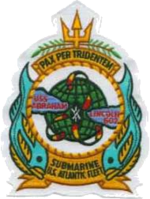USSAbraham Lincoln(SSBN-602)
 Abraham Lincolntravelling on the surface
| |
| History | |
|---|---|
| Namesake | Abraham Lincoln |
| Ordered | 30 July 1958[1] |
| Builder | Portsmouth Naval Shipyard[1] |
| Laid down | 1 November 1958 |
| Launched | 14 May 1960 |
| Sponsored by | Mary L. Beckwith |
| Commissioned | 11 March 1961[1] |
| Decommissioned | 28 February 1981[1] |
| Stricken | 1 December 1982 |
| Fate | Recycled viaSubmarine recycling10 May 1994 |
| Badge |  |
| General characteristics | |
| Class and type | George Washington-classsubmarine |
| Displacement | |
| Length | 381.6 ft (116.3 m)[1] |
| Beam | 33 ft (10 m)[1] |
| Draft | 29 ft (8.8 m)[1] |
| Propulsion | |
| Speed | |
| Range | unlimited except by food supplies |
| Test depth | 700 ft (210 m)[1] |
| Complement | Two crews (Blue/Gold) each consisting of 12 officers and 100 enlisted |
| Armament |
|
USSAbraham Lincoln(SSBN-602),aGeorge Washington-classfleet ballistic missile submarine,was the second ship of theUnited States Navyto be named forAbraham Lincoln,the 16th President of the United States (1861–1865), the first beingUSSPresident Lincoln(1907).
Herkeelwaslaid downby thePortsmouth Naval ShipyardofKittery, Maine,on 1 November 1958. She waslaunchedon 14 May 1960 sponsored byMary L. Beckwith[2](great-granddaughter of President Abraham Lincoln), andcommissionedon 8 March 1961 withCommanderLeonard Erb commanding the Blue Crew and Commander Donald M. Miller commanding the Gold Crew.
Atlantic operations[edit]
Abraham Lincolngot underway on 20 March 1961 forshakedownand weapons testing atCape Canaveral, Florida,and returned to Portsmouth Naval Shipyard on 1 June for post-shakedown repairs. She left Portsmouth Naval Shipyard on 17 July 1961 to return briefly to Cape Canaveral for further testing and then proceeded toCharleston, South Carolina,for a final loadout.Abraham Lincolnsubsequently got underway on 28 August 1961 as a unit ofSUBRON 14.She arrived atHoly Loch,Scotland, in October 1961. She underwent a refit alongsidesubmarine tenderUSSProteusduring November 1961 and, upon its completion, commenced her first deterrent patrol.

Abraham Lincolnoperated out of Holy Loch for the next four years. She alternated periods of upkeep at Holy Loch alongsideProteusor submarine tenderUSSHunleywith deterrent patrols from that port.
A highlight of this period occurred during theCuban Missile Crisisof October 1962.Abraham Lincolnwas in the middle of a scheduled four-week upkeep period when she received orders to deploy. She departed in short order and successfully carried out a 65-day patrol.
On 13 October 1965,Abraham Lincolnarrived atGroton, Connecticut,and entered theElectric Boatshipyard there on 25 October 1965 to begin anoverhaul and refueling.
This work was completed on 3 June 1967, andAbraham Lincolnreturned to her base at Holy Loch and resumed her schedule of deterrent patrols. She continued the pattern of alternating patrols with periods of upkeep alongside either submarine tenderUSSSimon Lakeor submarine tenderUSSCanopusthrough 1972.
In early March 1972,Abraham Lincolndeparted for the United States and arrived atNaval Submarine Base New Londonat Groton, Connecticut, on 25 April 1972. She held twodependents' cruisesbefore getting underway on 19 May for theUnited States West Coastto join theUnited States Pacific Fleet.Abraham Lincolnmade a brief visit toFort Lauderdale, Florida,transited thePanama Canalon 1 June, sailed toBangor, Washington,to offload her missiles, then pushed on to San Francisco. On 25 June 1972,Abraham Lincolnentered theMare Island Naval ShipyardatVallejo, California,to commence overhaul and refueling.
Pacific operations[edit]
The extensive overhaul was completed in December 1973. After shakedown in the areas aroundPuget Soundand San DiegoAbraham Lincolntransited thePanama Canalon 1 June 1974. She held tests and local operations atCape CanaveralandCharleston, South Carolina.She retransitted the Panama Canal on 26 July 1974 and proceeded to her newhome port,Pearl Harbor,Hawaii, where she arrived on 10 September 1974 to become part of CINCPAC Fleet and Squadron 15. She then continued on to her advanced base atGuam,arriving on 18 October 1974. She then began deterrent patrols in theMariana Islandsfrom Guam, which she carried out until 1978. She also participated in numerous tests and exercises. During this period,Abraham Lincolnbecame the first ballistic missile submarine to have conducted 50 strategic deterrent patrols, completing her 50th in 1978.
Deactivation, decommissioning, and disposal[edit]
Abraham Lincolncompleted her last patrol in October 1979 and arrived atBangor, Washington,on 30 October 1979 to commence offloading her missiles before beginning inactivation overhaul. Preparations for her retirement continued through 1980 and into 1981.
Abraham Lincolnwasdecommissionedon 28 February 1981 and stricken from theNaval Vessel Registeron 1 December 1982. She was disposed of through theShip and Submarine Recycling Programon 10 May 1994 at thePuget Sound Naval Shipyard.
Part of the sail fromAbraham Lincolnwas used to replace the damaged sail onUSSGeorge Washingtonafter its collision withNissho Maru.This sail is on display at theSubmarine Force Library and Museum,near Groton.
References[edit]
- ^abcdefghijklmnopqr"SSBN-598 George Washington-Class FBM Submarines" from the FAS
- ^Emerson, Jason (14 April 2021)."Lincoln's Descendant Disliked Her Famous Heritage".JasonEmerson (Lincoln Historian).Retrieved9 November2022.
On May 14, 1960, the new ballistic-missile, nuclear-powered submarineAbraham Lincolnwas launched from Portsmouth, N.H. Mary Lincoln Beckwith, dressed uncharacteristically in a blue and white polka dot dress, white gloves, white hat, and a pearl necklace, broke a bottle of champagne on the bow and christened the ship. How impressed she was by the occasion is found in her diary, in which she recorded that night: "Cloudy a.m. Sun out p.m. Broke bottle on boat. So home to bed." "Mary Lincoln Beckwith died July 10, 1975 in Rutland, Vt., from colon cancer at the age of seventy-seven. She never married or had any children."
![]() This article incorporates text from thepublic domainDictionary of American Naval Fighting Ships.The entry can be foundhere.
This article incorporates text from thepublic domainDictionary of American Naval Fighting Ships.The entry can be foundhere.
![]() This article incorporates text from thepublic domainDictionary of American Naval Fighting Ships.The entry can be foundhere.
This article incorporates text from thepublic domainDictionary of American Naval Fighting Ships.The entry can be foundhere.
